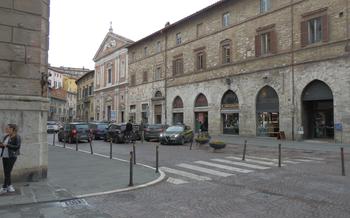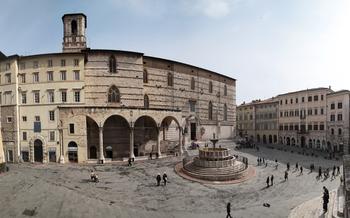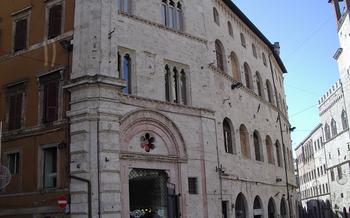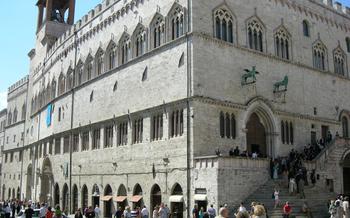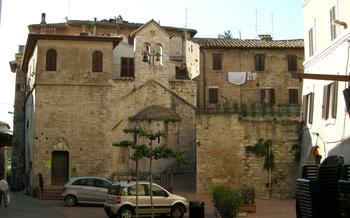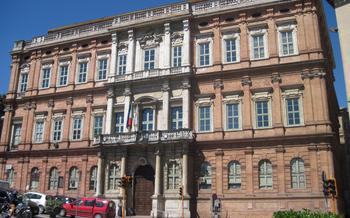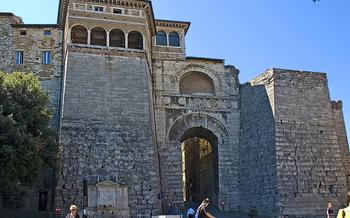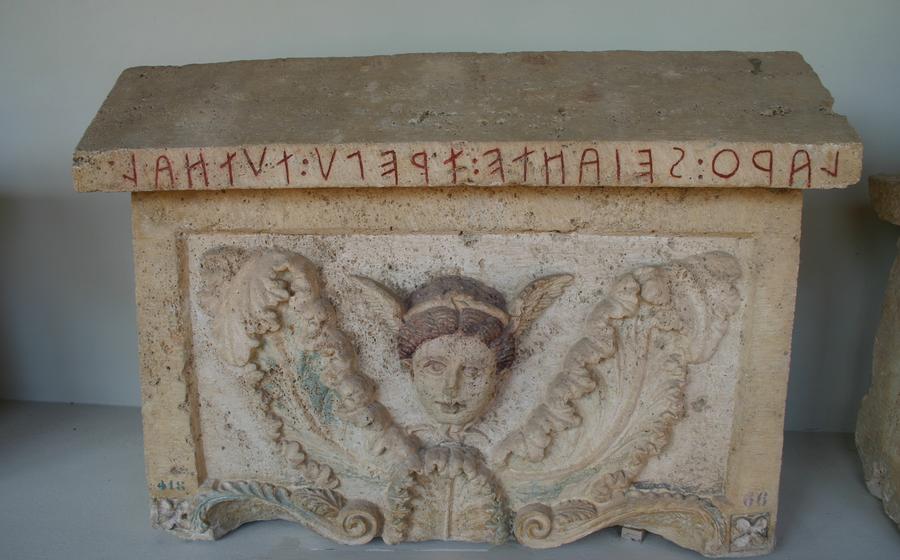
Museo Archeologico di Perugia (Archeological Museum)
- History of the Museum:
- Location:
- Roman Collection
- Medieval Collection
- Temporary Exhibitions
- Educational Programs
- Accessibility:
- Museum Shop
- Hours of Operation
- Admission Fees
- Nearby Attractions
- Insider Tip:
History of the Museum:
The Museo Archeologico di Perugia, nestled in the heart of the picturesque city of Perugia, holds a significant place in the annals of archaeological exploration and historical preservation in Umbria. Its genesis can be traced back to the late 19th century when the passion and dedication of local antiquarians and scholars coalesced into a movement to safeguard the region's rich archaeological heritage. In 1871, this collective endeavor culminated in the establishment of the Museo Civico di Perugia, which would eventually evolve into the Museo Archeologico di Perugia.
Initially housed in the Palazzo Comunale, the museum's collection grew steadily through donations and excavations, reflecting the increasing interest in the region's past. In 1910, the museum found a more suitable home in the former convent of San Domenico, a historic building that provided much-needed space to showcase the expanding collection.
The museum's mission to preserve and promote the cultural heritage of Perugia and its surroundings has endured over the decades. Through its extensive collection, the Museo Archeologico di Perugia offers visitors a window into the region's captivating history, from the enigmatic Etruscan civilization to the grandeur of the Roman Empire and the intricate tapestry of the Middle Ages.
Location:
The Museo Archeologico di Perugia is conveniently situated in the heart of the city, making it easily accessible to visitors. It is located on Via Ulisse Rocchi, a charming street that leads to the Piazza IV Novembre, the city's main square. To get to the museum by public transportation, you can take the local bus that stops right in front of the museum entrance. If you are traveling by car, there are several parking garages nearby where you can leave your vehicle and walk to the museum. Once you arrive, you will be captivated by the museum's impressive facade, adorned with intricate carvings and sculptures that hint at the treasures that await inside.
Roman Collection
The Roman collection at the Museo Archeologico di Perugia offers a fascinating glimpse into the influence and legacy of the Roman Empire in the region. Among the notable artifacts on display are a variety of mosaics, which depict scenes from mythology and everyday life, providing visitors with a visual representation of Roman culture and artistry. The museum also houses a collection of coins from different periods of Roman history, which showcase the evolution of Roman currency and its role in trade and commerce. Additionally, visitors can admire a number of inscriptions, such as tombstones and votive offerings, which provide valuable insights into the lives and beliefs of the ancient Romans who once inhabited the area. These artifacts collectively paint a vivid picture of Roman life in Perugia and its surrounding territories, allowing visitors to delve into the rich history of this influential civilization.
Medieval Collection
The medieval collection at the Museo Archeologico di Perugia offers a fascinating glimpse into the city's rich history during the Middle Ages. Visitors can explore a wide range of artifacts that shed light on the religious, political, and cultural life of Perugia and the region during this period.
Highlights of the collection include an impressive array of weapons and armor, providing insights into the city's military prowess and the conflicts that shaped its medieval history. Intricate religious objects, such as finely crafted chalices, reliquaries, and sculptures, showcase the deep religious devotion that characterized this era.
Among the collection's most captivating pieces is a remarkable collection of illuminated manuscripts. These beautifully illustrated books, created by skilled scribes and artists, offer a glimpse into the intellectual and artistic achievements of the medieval period. Visitors can admire the vibrant colors, intricate details, and captivating narratives that adorn these precious works of art.
The medieval collection at the Museo Archeologico di Perugia is a treasure trove of insights into the city's fascinating past. It invites visitors to delve into a world of knights, battles, religious devotion, and artistic brilliance, providing a deeper understanding of Perugia's medieval heritage.
Temporary Exhibitions
The Museo Archeologico di Perugia frequently hosts temporary exhibitions alongside its permanent collection. These exhibitions showcase a wide range of artifacts and themes related to the region's history and archaeology. Past exhibitions have explored topics such as the Etruscan civilization, the Roman Empire, and the Middle Ages. Visitors can check the museum's website or social media pages to find out about upcoming exhibitions and their themes. These temporary exhibitions offer an opportunity for visitors to see new and exciting artifacts and learn about different aspects of the region's rich history and culture.
Educational Programs
In addition to its impressive collection of artifacts, the Museo Archeologico di Perugia also offers a variety of educational programs designed to engage and enlighten visitors of all ages. These programs include guided tours that provide in-depth insights into the museum's exhibits, as well as workshops and lectures that explore specific aspects of archaeology and history. The museum's knowledgeable and experienced staff are passionate about sharing their knowledge and fostering a deeper understanding of the region's rich cultural heritage. Whether you are a student, a history buff, or simply someone who enjoys learning new things, the Museo Archeologico di Perugia's educational programs offer a unique and enriching experience. To find out more about upcoming programs and to book your spot, visit the museum's website or inquire at the information desk upon your visit.
Accessibility:
The Museo Archeologico di Perugia is committed to providing an accessible and inclusive experience for all visitors. The museum is wheelchair accessible, with ramps and elevators connecting all floors. Visitors with disabilities can also borrow wheelchairs from the museum upon request. Audio guides are available in multiple languages and are equipped with features for the visually and hearing impaired. The museum staff is trained to assist visitors with disabilities and can provide any necessary assistance. With these accommodations in place, visitors of all abilities can fully enjoy and appreciate the museum's rich collection of artifacts and explore the fascinating history of Perugia and the surrounding region.
Museum Shop
The Museo Archeologico di Perugia has a well-stocked museum shop where visitors can purchase a variety of souvenirs and merchandise related to the museum's collections and the history of Perugia. The shop offers a wide selection of items, including books on Etruscan, Roman, and medieval history and archaeology, postcards featuring images of the museum's artifacts and the city of Perugia, and replicas of Etruscan and Roman jewelry, pottery, and bronzes. Visitors can also find a variety of other souvenirs, such as t-shirts, mugs, and magnets, as well as unique gifts for friends and family. The museum shop is located on the ground floor of the museum and is open during the same hours as the museum itself.
Hours of Operation
The Museo Archeologico di Perugia is open to the public from Tuesday to Sunday. Opening hours are from 8:30 AM to 7:30 PM, with the last admission at 7:00 PM. However, it is important to note that the museum has reduced hours on Mondays, when it is open from 8:30 AM to 1:30 PM. It is always advisable to check the museum's official website or contact them directly for any updates or changes in their operating hours, especially during holidays or special events.
Admission Fees
Admission to the Museo Archeologico di Perugia is very reasonable, making it an accessible attraction for visitors of all budgets. The standard admission fee for adults is €00, while reduced tickets are available for students, seniors, and visitors with disabilities, who pay €00. Children under the age of 18 are admitted free of charge.
The museum also offers a family ticket for €00, which admits two adults and two children. This is a great option for families who want to enjoy a day of history and culture together.
On the first Sunday of each month, the museum offers free admission to all visitors. This is a great opportunity to visit the museum without having to worry about the cost.
Please note that the museum may offer special exhibitions or events that require a separate admission fee. It is always a good idea to check the museum's website or contact them directly for the most up-to-date information on admission fees and discounts.
Nearby Attractions
After exploring the rich history and archaeology of the Museo Archeologico di Perugia, visitors may want to delve further into the city's cultural and architectural heritage. Fortunately, Perugia offers a variety of nearby attractions within easy walking distance of the museum.
One must-see destination is the Palazzo dei Priori, an imposing medieval palace that now houses the Galleria Nazionale dell'Umbria, a renowned art gallery showcasing masterpieces from the Umbrian school of painting. The gallery's collection includes works by Perugino, Raphael, and Pinturicchio, offering visitors a glimpse into the region's artistic legacy.
Another highlight of Perugia is the Fontana Maggiore, an elaborate medieval fountain located in the heart of the city. Constructed in the 13th century, the fountain is adorned with intricate sculptures and bas-reliefs depicting biblical scenes and mythological figures. Its unique design and historical significance make it a popular attraction for visitors and locals alike.
For those interested in exploring the Etruscan roots of the region, the Etruscan Arch, also known as the Arch of Augustus, is a well-preserved Etruscan gate dating back to the 3rd century BC. The arch stands as a testament to the engineering prowess of the Etruscans and offers visitors a glimpse into the city's ancient past.
These attractions, along with many others, provide visitors with a comprehensive experience of Perugia's rich cultural heritage, making it an ideal destination for history enthusiasts, art lovers, and anyone seeking a deeper understanding of Umbria's past.
Insider Tip:
Perugia's underground is a treasure trove of ancient secrets waiting to be unveiled. Beneath the city's modern streets lies an intricate network of Etruscan tunnels, chambers, and cisterns, dating back to the 4th century BC. These hidden marvels offer a unique glimpse into the city's rich history and engineering prowess. While not officially open to the public, guided tours are occasionally organized, allowing visitors a rare opportunity to explore this subterranean labyrinth. Inquire at the Museo Archeologico di Perugia for more information and to learn about upcoming tours.
